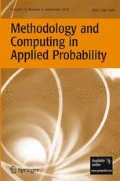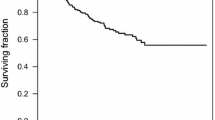Abstract
Cure rate models offer a convenient way to model time-to-event data by allowing a proportion of individuals in the population to be completely cured so that they never face the event of interest (say, death). The most studied cure rate models can be defined through a competing cause scenario in which the random variables corresponding to the time-to-event for each competing causes are conditionally independent and identically distributed while the actual number of competing causes is a latent discrete random variable. The main interest is then in the estimation of the cured proportion as well as in developing inference about failure times of the susceptibles. The existing literature consists of parametric and non/semi-parametric approaches, while the expectation maximization (EM) algorithm offers an efficient tool for the estimation of the model parameters due to the presence of right censoring in the data. In this paper, we study the cases wherein the number of competing causes is either a binary or Poisson random variable and a piecewise linear function is used for modeling the hazard function of the time-to-event. Exact likelihood inference is then developed based on the EM algorithm and the inverse of the observed information matrix is used for developing asymptotic confidence intervals. The Monte Carlo simulation study demonstrates the accuracy of the proposed non-parametric approach compared to the results attained from the true correct parametric model. The proposed model and the inferential method is finally illustrated with a data set on cutaneous melanoma.
Similar content being viewed by others
References
Arbutiski T (1985) A family of multiplicative survival models incorporating a long-term survivorship parameter c as a function of covariates. Comm Stat Theo Meth 14:1627–1642
Balakrishnan N, Pal S (2012) EM algorithm-based likelihood estimation for some cure rate models. J Stat Theo Prac 6:698–724
Balakrishnan N, Pal S (2013a) Lognormal lifetimes and likelihood-based inference for flexible cure rate models based on COM-Poisson family. Comput Stat Data Anal 67:41–67
Balakrishnan N, Pal S (2013b) Expectation maximization-based likelihood inference for flexible cure rate models with Weibull lifetimes. Stat Methods Med Res. doi:10.1177/0962280213491641. available online
Balakrishnan N, Pal S (2013c) COM-Poisson cure rate models and associated likelihood-based inference with exponential and Weibull lifetimes. In: Balakrishnan N., Pal S (eds) Applied Reliability Engineering and Risk Analysis: Probabilistic Models and Statistical Inference, Chapter 22. Wiley, UK, pp 308–348
Berkson J, Gage RP (1952) Survival curves for cancer patients following treatment. J Am Stat Assoc 47:501–515
Betensky RA, Schoenfeld DA (2001) Nonparametric estimation in a cure model with random cure times. Biometrics 57:282–286
Boag JM (1949) Maximum likelihood estimates of the proportion of patients cured by cancer therapy. J R Stat Soc Ser B 11:15–44
Broet P, Rycke Y, Tubert-Bitter P, Lellouch J, Asselain B, Moreau T (2001) A semiparametric approach for the two-sample comparison of survival times with long-term survivors. Biometrics 57:844–852
Cantor AB, Shuster JJ (1992) Parametric versus non-parametric methods for estimating cure rates based on censored survival data. Stat Med 11:931–937
Castro MD, Cancho VG, Rodrigues J (2009) A Bayesian long-term survival model parametrized in the cured fraction. Biom J 51:443–455
Chen MH, Ibrahim JG (2001) Maximum likelihood methods for cure rate models with missing covariates. Biometrics 57:43–52
Chen MH, Ibrahim JG, Sinha D (1999) A new Bayesian model for survival data with a surviving fraction. J Am Stat Assoc 94:909–919
de Freitas LA, Rodrigues J (2013) Standard exponential cure rate model with informative censoring. Comm Stat Sim Comp 42:8–23
Fang HB, Li G, Sun J (2005) Maximum likelihood estimation in a semiparametric logistic/proportional-hazards mixture model. Scand J Stat 32:59–75
Farewell VT (1977) A model for a binary variable with time-censored observations. Biometrika 64:43–46
Farewell VT (1982) The use of mixture models for the analysis of survival data with long-term survivors. Biometrics 38:1041–1046
Farewell VT (1986) Mixture models in survival analysis: are they worth the risk Can J Stat 14:257–262
Ghitany ME (1993) On the information matrix of exponential mixture models with long-term survivors. Biom J 35:15–27
Ghitany ME, Maller RA (1992) Asymptotic results for exponential mixture models with long-term survivors. Statistics 23:321–336
Goldman AI (1984) Survivorship analysis when cure is a possibility: a Monte Carlo study. Stat Med 3:153–163
Hu T, Xiang L (2013) Efficient estimation for semiparametric cure models with interval-censored data. J Multivar Anal 121:139–151
Ibrahim JG, Chen MH, Sinha D (2001) Bayesian semiparametric models for survival data with a cure fraction. Biometrics 57:383–388
Ibrahim JG, Chen MH, Sinha D (2005) Bayesian Survival Analysis. Wiley, New York
Kim S, Chen MH, Dey DK, Gamerman D (2007) Bayesian dynamic models for survival data with a cure fraction. Lifetime Data Anal 13:17–35
Kim S, Xi Y, Chen MH (2009) A new latent cure rate marker model for survival data. Ann Appl Stat 3:1124–1146
Kuk AY, Chen CH (1992) A mixture model combining logistic regression with proportional hazards regression. Biometrika 79:531–541
Larson MG, Dinse GE (1985) A mixture model for the regression analysis of competing risks data. Appl Stat 34:201–211
Laska EM, Meisner MJ (1992) Nonparametric estimation and testing in a cure model. Biometrics 48:1223–1234
Li CS, Taylor JM, Sy JP (2001) Identifiability of cure models. Stat Prob Lett 54:389–395
Liu H, Shen Y (2009) A semiparametric regression cure model for interval-censored data. J Am Stat Assoc 104:1168–1178
Liu M, Lu W, Shao Y (2006) Interval mapping of quantitative trait loci for time-to-event data with the proportional hazards mixture cure model. Biometrics 62:1053–1061
Lo YC, Taylor JM, McBride WH, Withers HR (1993) The effect of fractionated doses of radiation on mouse spinal cord. Int J Radiat Oncol Biol Phys 27:309–317
Lu W (2008) Maximum likelihood estimation in the proportional hazards cure model. Ann Inst Stat Math 60:545–574
Maller RA, Zhou X (1992) Estimating the proportion of immunes in a censored sample. Biometrika 79:731–739
Maller RA, Zhou X (1996) Survival Analysis with Long-term Survivors. Wiley, New York
Maller RA, Zhou S (1995) Testing for the presence of immune or cured individuals in censored survival data. Biometrics 1197–1205
Peng Y, Dear KB (2000) A nonparametric mixture model for cure rate estimation. Biometrics 56:237–243
Peng Y, Dear KB, Denham JW (1998) A generalized F mixture model for cure rate estimation. Stat Med 17:813–830
Rodrigues J, de Castro M, Balakrishnan N, Cancho V G (2011) Destructive weighted Poisson cure rate models. Lifetime Data Anal 17:333–346
Rodrigues J, Cancho V G, de Castro M, Louzada-Neto F (2009) On the unification of long-term survival models. Stat Prob Lett 79:753–759
Sposto R, Sather HN, Baker SA (1992) A comparison of tests of the difference in the proportion of patients who are cured. Biometrics 48:87–99
Struthers CA, Farewell VT (1989) A mixture model for time to AIDS data with left truncation and an uncertain origin. Biometrika 76:814–817
Sy JP, Taylor JM (2000) Estimation in a Cox proportional hazards cure model. Biometrics 56:227–236
Sy JP, Taylor JM (2001) Standard errors for the Cox proportional hazards cure model. Math Comput Model 33:1237–1251
Taylor JM (1995) Semi-parametric estimation in failure time mixture models. Biometrics 51:899–907
Tournoud M, Ecochard R (2008) Promotion time models with time-changing exposure and heterogeneity: application to infectious diseases. Biom J 50:395–407
Tsodikov A (1998a) A proportional hazards model taking account of long-term survivors. Biometrics:1508–1516
Tsodikov A (1998b) Asymptotic efficiency of a proportional hazards model with cure. Stat Prob Lett 39:237–244
Tsodikov A (2001) Estimation of survival based on proportional hazards when cure is a possibility. Math Comput Model 33:1227–1236
Tsodikov AD, Ibrahim JG, Yakovlev AY (2003) Estimating cure rates from survival data. J Am Stat Assoc 98:1063–1078
Yakovlev AY, Cantor AB, Shuster JJ (1994) Parametric versus non-parametric methods for estimating cure rates based on censored survival data. Stat Med 13:983–986
Yakovlev AY, Tsodikov AD (1996) Stochastic Models of Tumor Latency and their Biostatistical Applications (Vol 1). World Scientific, Singapore
Yamaguchi K (1992) Accelerated failure-time regression models with a regression model of surviving fraction: an application to the analysis of “permanent employment” in Japan. J Am Stat Assoc 87:284–292
Zhao L, Feng D, Bellile EL, Taylor JM (2014) Bayesian random threshold estimation in a Cox proportional hazards cure model. Stat Med 33:650–661
Author information
Authors and Affiliations
Corresponding author
Additional information
F. S. Milienos research is supported by a Marie Curie International Outgoing Fellowship within the 7th European Community Framework Programme.
Rights and permissions
About this article
Cite this article
Balakrishnan, N., Koutras, M.V., Milienos, F.S. et al. Piecewise Linear Approximations for Cure Rate Models and Associated Inferential Issues. Methodol Comput Appl Probab 18, 937–966 (2016). https://doi.org/10.1007/s11009-015-9477-0
Received:
Revised:
Accepted:
Published:
Issue Date:
DOI: https://doi.org/10.1007/s11009-015-9477-0
Keywords
- Cure rate models
- Competing causes
- Maximum likelihood estimators
- EM algorithm
- Lifetime data
- Exponential distribution
- Weibull distribution
- Piecewise constant/linear approximations
- Cutaneous melanoma data




